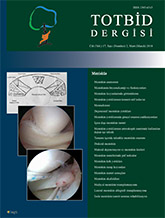
Meniscus repair is not always possible after chronic damage and extensive rupture of the meniscus. Even if anatomical repair of meniscus is performed, more than 25% failure is seen in patients after meniscal repair. Large ruptures of the meniscus, especially in avascular part, are not able to repair, and these parts of the meniscus are resected. A meniscus scaffold idea was introduced to replace the meniscus tissue in order to protect the knee against the effects of osteoarthritis that may develop after meniscal rupture and resection. The aim of the meniscus scaffold treatment is to delay or prevent degenerative changes that may occur after meniscectomy by mimicking the anatomical and fibrocartilaginous properties of the meniscus. There are two different meniscus scaffold types: in collagen and polyurethane structure. It has been reported that there is a significant increase in the functional outcomes of patients following meniscal scaffold applications. However, the failure rate of meniscal scaffolds varies between 17.3% and 46.7% depending on problems such as meniscal extrusion and resorption. Platelet-rich plasma and mesenchymal stem cell-added scaffolds are being studied to activate the meniscus scaffold cellularity, and to obtain a normal meniscus-like matrix.